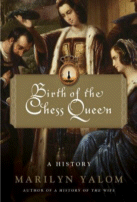Birth of the Chess Queen
HarperCollins, April, 2004.
Hardcover, 272 pages.
ISBN: 0060090642
 It always happens. A person of any age being introduced to the basic
rules of the venerable and intriguing game of chess is always astonished
by the moves allotted to the only female chess piece, the powerful
and dangerous queen. She can move on the diagonal like the bishop
or across the board like the castle. After the king, who is the object
of the game, she is clearly the most valuable piece. Most followers
of the game of chess will most likely have books that discuss famous
games, devious but perfectly logical gambits, and endgames that will
leave an opponent in the throes of inevitable defeat. But along with
these excellent and useful books, the history of the pieces, their
moves and the evolution of this ancient game as it interacts with
European history will definitely be an important addition to the
chess enthusiast's collection.
It always happens. A person of any age being introduced to the basic
rules of the venerable and intriguing game of chess is always astonished
by the moves allotted to the only female chess piece, the powerful
and dangerous queen. She can move on the diagonal like the bishop
or across the board like the castle. After the king, who is the object
of the game, she is clearly the most valuable piece. Most followers
of the game of chess will most likely have books that discuss famous
games, devious but perfectly logical gambits, and endgames that will
leave an opponent in the throes of inevitable defeat. But along with
these excellent and useful books, the history of the pieces, their
moves and the evolution of this ancient game as it interacts with
European history will definitely be an important addition to the
chess enthusiast's collection.
The rise of the chess queen begins, not surprisingly, in fifteenth century Spain and the collision of two cultures: European Christian and Eastern Muslim. Beginning in India with pieces representing armies made up of infantry, chariots, elephants, cavalry plus a king and a general and played on a board of sixty-four squares, chess moved to Persia. From Persia, chess moved with the spread of the Muslim faith. In Spain, the two cultures coexisted for a while and the game took on different characteristics. The game the Muslims brought had no female pieces. The vizier was the piece next to the king. Additionally, the pieces were symbolic in nature due to the religious restriction on images. Slowly, the power of queens in European governments turned the Muslim vizier into the chess queen on the chess board. The story of the importance of queens with their vast dowries of real estate and peasants is most interesting. One of the most delightful of the queens was Queen Toda of Navarre who overcame widowhood and ambitious neighbors, and formed powerful alliances of her own. She even supervised a self improvement program for one of her grandsons so that he could ride a horse in a procession, a skill that he had been unable to master before his grandmother took over. She secured a trainer for him and supervised his diet and exercise until he was fit to assume his role as king. There were so many different kingdoms throughout the continent that there were many queens to add their stories to the general culture.
The Birth of the Chess Queen is not only about chess, but about the cultural history of a continent that came to dominate the world. If chess is the game of royalty, then how did the queen become such a powerful piece? How did her moves on the chessboard reflect the realities of government for 500 years? Marilyn Yalom's scholarship is comprehensive and unbiased, and it fills in the gaps in our knowledge of the evolution of western culture. By telling the story of a game that was so widely popular that the clergy regularly condemned it, the author tells us the other half of history: the part played by women.
--Sarah Reaves White
Birth of the Chess Queen is available for purchase on Amazon.com
Note: We may receive a commission from sales made through product links in this article.
This review was published in the July-August, 2004 of The Internet Writing Journal.
Copyright © Writers Write, Inc. All Rights Reserved.
